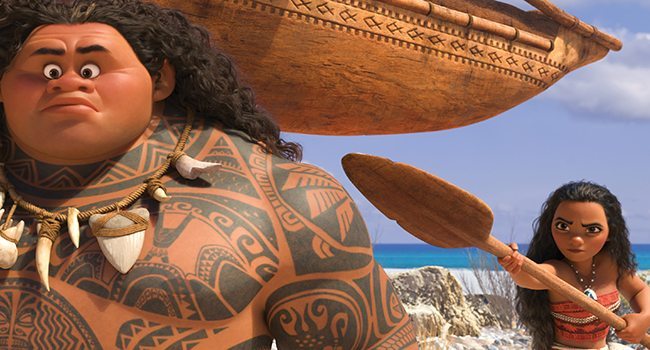I recently had the good fortune to sit down with Darrin Butters, an animator for Walt Disney Animation Studios that has worked on classics like “Big Hero 6,” “Zootopia” and this week’s “Moana.” He took some time between guest presentations at ASU to answer my questions about Arizona, the art of animation, his favorite Disney movie, and more:
Ryan Bordow: I write for AZ Big Media, so my first question is this: what do you think of Arizona?
Darrin Butters: Ah, I love Arizona. You know, what struck me was — I’m originally from Nebraska. In California there’s mountains everywhere around the valley and so you never get to see the horizon. And one thing that struck me here was the huge sky: it reminded me of back home. And so far everybody that I’ve met here is sweet as pie.
RB: That’s nice!
DB: Yeah, yeah! I love the people. I haven’t gotten my chance to get around the town at all, but from what I’ve seen I love it.
RB: Good to know. So what originally drew you to artistic endeavors — storytelling and animating?
DB: My older brother was an artist and I always wanted to do what he was doing. You know follow in his footsteps and just tag along. He was always drawing comic books, and I kind of started drawing at a very young age, and we would always make flipbooks. You know, where you draw on the corner of the- [mimes flipping through a flipbook]
RB: Ah, yeah, of course.
DB: That fascinated me. I kind of — my high school job was at a t-shirt design, I was a designer of t-shirts at a screen-printing shop. They brought in a Macintosh with Adobe Illustrator ’88 on it — which shows you how old I am — and they wanted us to do our designs in the computer: color separations and stuff like that. So I started becoming computer literate, and then the whole desktop publishing thing blew up with Photoshop and stuff like that. My artistic background seeped into that. And I’ve always been a performer: I did puppet shows and magic shows. I was that kid.
RB: I was also that kid. I did both of those things.
DB: [Laughs] Right! Theater, improv, stuff like that. Those two things — the performing and the art — was a perfect match in animation. I could draw characters and make them move and perform. That was my route to animation. Does that make sense?
RB: Yeah, that makes sense. What does animation have over other forms of art when telling a story and developing characters?
DB: I like the heightened reality that you can give to a character. You can make a sad character super sad; you can make a wacky character super wacky. We can do the impossible. We can make a character have ice powers, we can make a girl with seventy feet of hair go on this incredible journey, we can make a demigod with animated tattoos that talk to him. That — that’s why we do animation. It’s that element of magic.
RB: I can see how the magic of the flipbooks extended into your adulthood.
DB: [Laughs] I can do anything! And I WILL.
RB: So what are the challenges that come from animating a specific culture? I know that this film [Moana] tackles a lot of Polynesian culture.
DB: Right. We were very sensitive to how we approached this story. We were checking in with our “Oceanic Story Trust” — which was like anthropologists, archeologists, elders, fishermen, dancers from Polynesia— constantly checking in with them for their input on design. We were very respectful of how we approached that portrayal of that part of the country. We were so inspired by the people that we met on our research trips and just listening to their stories. It’s important that we portray that culture in a responsible light.
RB: Perfect. Are there any new challenges you face today in animation or new discoveries that really excite you?
DB: We’re able to generate elements and characters in our movies that are indistinguishable from live action. I think the trick now is to create characters that fit into that realism seamlessly. I’m a big fan of that snappy, really sharp, caricatured animation. And that’s a challenge in computer animation because the computer wants to make everything smooth.
RB: That’s interesting. I’ve never thought of animation as sort of a struggle against the computer.
DB: Yeah. [Laughs] It’s kind of like the computer wants to make bad animation by nature. That’s something that we’re struggling with in computer animation all the time: don’t make it look like computer animation. You want it to be so believable that it keeps people in the story, in the moment — rather than pull them out by thinking, oh-
RB: -that’s computer animation.
DB: [Laughs] Good ol’ computer animation.
RB: I don’t know if you’re allowed to answer this, but do you have a favorite project that you’ve worked on?
DB: I do. Tangled will always be very memorable for me. I think that as an animation group we learned so much on that picture and took our craft to a new level. I have to say Zootopia was a blast too.
RB: I adored that film and I loved the animation!
DB: Thank you, thank you! That will be unforgettable for me because I had the great fortune to animate the sloth laughing.
RB: [Laughs] What is your advice to any aspiring animators and artists here at ASU?
DB: My advice would be to make stuff. Make tons of stuff. Just make stuff and show it to people! And get feedback, honest feedback. Focus on the principles; don’t focus on the tools: don’t get caught up in ‘I need to learn this program’ or ‘I need to download this new software’. Study principles instead of tools.




